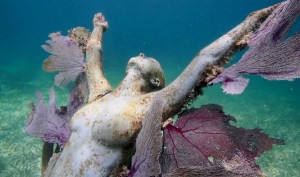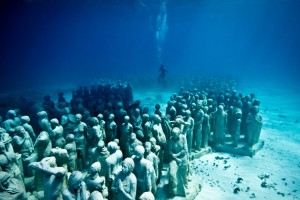In last week’s tutorial, Dr Todd shared with us the impacts of coastal urbanization on biodiversity. More importantly, he made us think about the types of mitigation and rehabilitation strategies we could adopt to enhance biodiversity of sea walls. This is especially relevant to conservation, given that coastal defences are likely to grow in the future, due to increasing urbanization and rising sea-levels. In this post, however, I would like to talk about the importance of scientific communication in aiding conservation efforts.
Over the weekend, I chanced upon a video that reminded me of the class activity I am sure we had all enjoyed (making our own tiles for sea walls!):
Underwater Sculptures Are Helping Rebuild Our Ocean’s Coral ReefsUnderwater artwork is helping rebuild our ocean’s coral reefs.
Posted by The Huffington Post on Wednesday, February 17, 2016
The video showed how a sculptor, Jason deCaires Taylor, made artworks from marine cement with a neutral surface pH and submerged them to form artificial reefs in the ocean. More than being just underwater art installations, these sculptures have allowed the growth of coralline algae on their surface, providing new opportunities and habitats for colonization and regeneration of reef ecosystems. In addition, these breathtaking artificial reefs, located in the off the shores of Mexico and the Caribbean, have diverted attention away from natural reefs that are threatened, allowing them to regenerate.
I thought it was a brilliant example of an innovative human intervention in marine conservation, and its positive impacts on the environment is heartening. Although I am not sure if the level of colonization on these sculptures is comparable to other restoration projects, Taylor’s projects have the potential to allow people to appreciate and connect with nature on a deeper level. Using art as a medium to raise awareness about the plight of the world’s coral reefs makes it more accessible to wider audiences, and highlights the beauty of nature. Such a form of scientific communication, that which frames human interventions as a source of hope, rather than a harbinger of doom, may compel more people to have greater concern for the environment.
Tying it back to what we have learnt in the tutorial, these sculptures have surfaces that are structurally complex, with various nooks and crannies. These surfaces may serve as a good anchor and provide microhabitats for algal and coral growth. In addition, the nature of marine cement allows it to resist currents and the cumulative slowing of currents by these sculptures, which can number up to 400 in a single location, may also contribute to a more stable low energy environment conducive for reef growth. Hence, it is interesting to note how these sculptures, while aesthetically pleasing, also fulfil certain rehabilitative requirements.
Perhaps it is time for us to view conservation in different lenses, expand our horizons, and seek innovative solutions to our environmental problems.
You can find out more about Taylor’s work through his website.


Awesome. If similar projects were initiated in Southeast Asia, do you think they would help mitigate the impacts of urbanisation on coastal and near-shore marine environments ? Why or why not ?